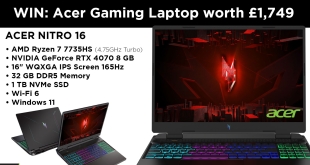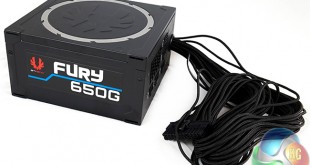
Bitfenix have earned a strong reputation in enthusiast circles thanks to their wide range of quality case designs. In the efforts to diversify their portfolio they recently launched a power supply range – dubbed the ‘Fury'. Available in three capacities – we look at the mid model today – the Fury 650W. These semi modular power supplies have all achieved 80 Plus Gold Certification and are competitively priced. One of the main talking points is actually the individually sleeved cabling, eye catching at this price point.
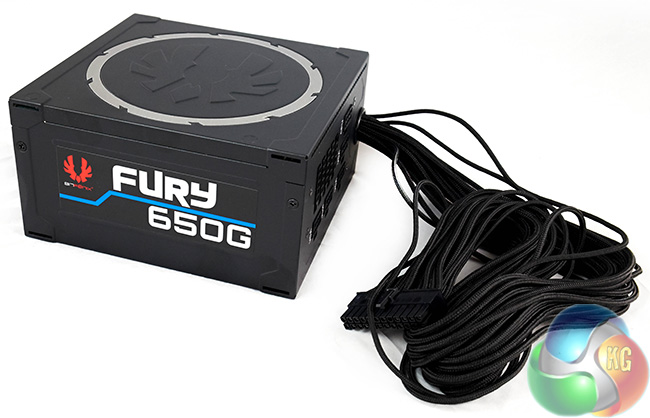
There is no doubt the Bitfenix Fury range of power supplies are designed to target the mass market of enthusiast users. We all love to read about the latest and greatest 1,500 watt power supplies, but very few of us with a single graphics card will ever need greater than a 650 watt power supply.
Specification:-
- Built by FSP, Designed by BitFenix.
- MTBF: 100,000 hours.
- Efficiency Rating: 80Plus Gold.
- PF Correction: Active.
- Protection Features: Over Voltage / Under Voltage / Over Current / Short Circuit / Over Temperature / Over Power.
- Safety Approvals: CB / TUV / ULOR CUL / BSMI.
- 3.3v: 26A.
- 5v: 26A.
- 12v: 50A.
- Total Power: 650W.
- Warranty: 5yr.
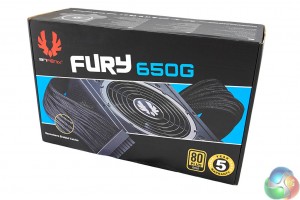
The BitFenix Fury 650G power supply arrives in a brightly coloured box with blue accents.
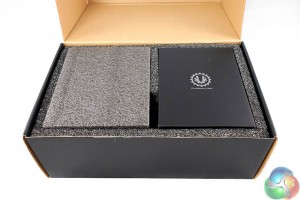
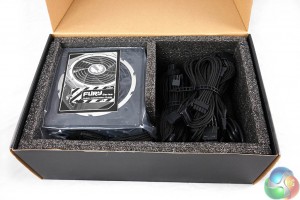
The packaging is very good, and the power supply itself is completely protected inside walls of thick foam on all sides. One section of the box houses the modular cabling.
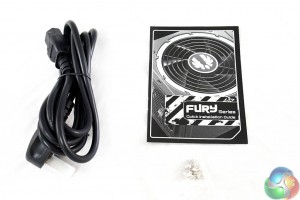
The bundle includes a regional specific power cable, mounting screws and a user manual.
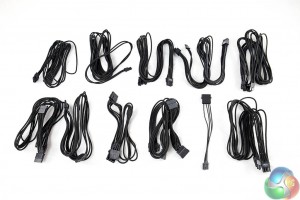
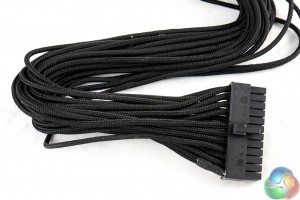
Bitfenix have individually sleeved the cables with their trademarked ‘NanoSleeve' braiding. They say ‘With an ultra-dense weave and superb flexibility, the Nanosleeve braiding found on our Alchemy cable extensions is the premier choice of the world's top modders. The cable that comes with the Fury are pre-sleeved with this exact sleeving, no more voiding your warranty and spending hours sleeving cables yourself. With Fury, you get that premium modded look straight out of the box.'
Marketing names aside, these will be popular among the enthusiast audience, as they really do look great, and will save many people having to mod their power supply later. Opting for plain black will ensure these cables suit any system.
| Cable | Connectors |
| ATX 20+4 pin | x1 (600mm) |
| 6+2 pin PCIe | x4 (600mm) |
| 4+4 pin EPS12V/ATX12V | x1 (650mm) |
| SATA | x6 / x4 (600mm + 100mm) |
| MOLEX | x3 (400mm + 150mm x 150mm) |
| MOLEX | x2 (500mm + 150mm) |
| FDD | x1 (+150mm) |
The main ATX cable is the only one hardwired into the chassis, which makes sense as you will always need it. All the other cables are modular. Bitfenix deserve a little credit for ensuring the cables are not only individually sleeved, but more than long enough, even for the largest cases you can buy today. The cables are standard 18AWG, which is correct according to industry ATX specifications.
There are four PCI-e cables included to suit a basic SLi and Crossfire configuration.

We like the design of the Bitfenix Fury 650G power supply. The Bitfenix logo is set to the side of the unit name, and capacity. The paintwork is quite deep and the unit passed our ‘screwdriver’ stress test, which involves running the head of a Philip’s screwdriver down the side of the chassis with weak to modest pressure. How often have you accidentally hit a power supply with some tools during a system build phase?
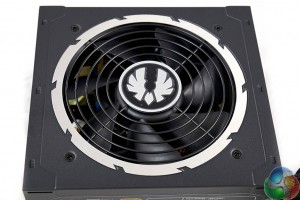
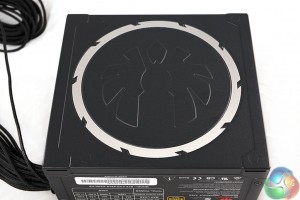
The top of the power supply is home to the fan grill, with the Bitfenix logo positioned in the center. The flip side of the chassis looks great – the company have embossed the logo into the metal chassis.
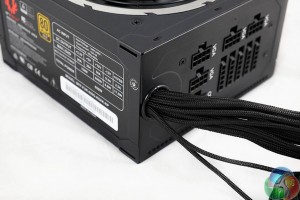
The sleeved ATX is fed into the chassis, next to the modular panel. There is a grommet here for protection against the metal surface.
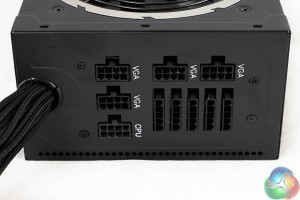
The build phase is easy to follow, as the company have clearly labelled the CPU and VGA connectors -running along the right and top of the panel. The peripheral cables are attached into the longer connectors mounted vertically alongside each other.
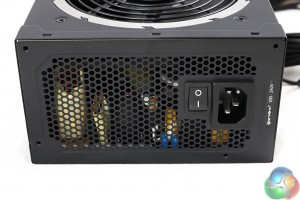
The other side of the chassis is honeycomb vented to help ensure good airflow when active. A power connector and switch rests alongside.
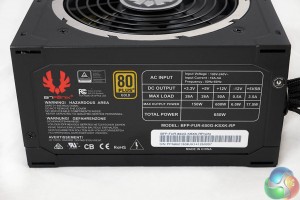
| Bitfenix Fury 650W Power Supply | |||||
|
DC Output
|
+5V
|
+3.3V
|
+12V |
-12V
|
+5Vsb
|
|
Max Output
|
26A
|
26A
|
50A |
0.5A
|
3.5A
|
| Max Combined Wattage | 150W | 600W | 6W | 17.5W | |
| 650W | |||||
The OEM has made the minor rails strong in this unit. A side effect of this is that the +12V rail can only deliver a maximum of 50A of power, for 600W of the total output.
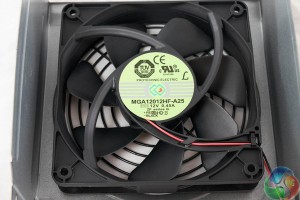
Inside is a Protechnic Electric fan (Model Number: MGA12012HD-A25). This is a quality fluid dynamic bearing fan rated at up to 2,400 rpm, 84.8CFM. This fan should last a long time, based on the high grade bearing technology.
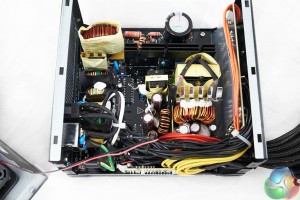
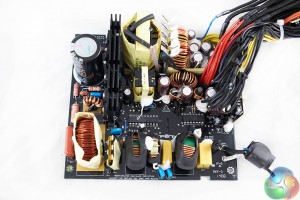
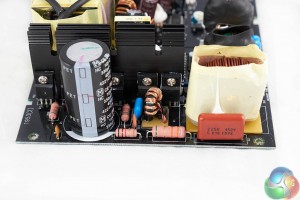
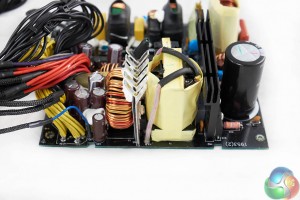
Bitfenix have paired up with FSP for the design of these power supplies (based on the Aurum platform). There are a noticeable lack of heatsinks populating the board, which raised my eyebrow immediately.
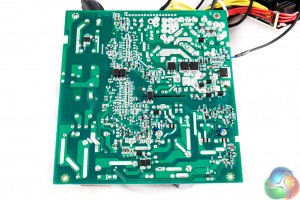
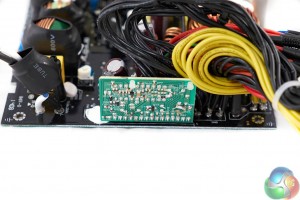
Soldering quality looks to be quite good, although it does fall short of the best work from the likes of Seasonic or Delta.
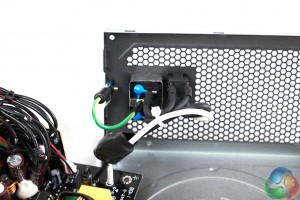
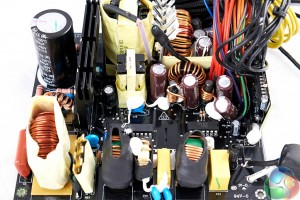
The first section of the transient filter at the AC receptacle includes a couple of Y caps. It moves over to the main PCB, a DM choke, four X and Y caps and two CM chokes. No Metal Oxide Varistor in this unit.
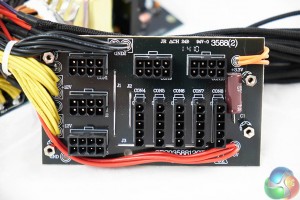
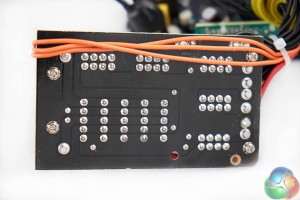
FSP have installed a Chemi Con electrolytic capacitor onto the front part of the modular PCB to help with ripple suppression.
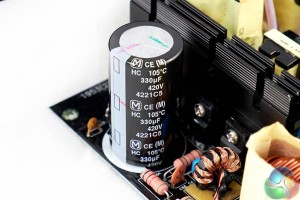
The design uses a high grade Japanese 105c rated capacitor in the primary stage – 330uF, 420V.
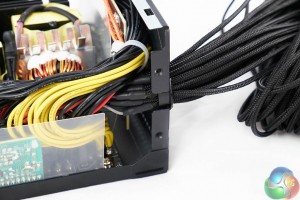
The cables are all sleeved into the chassis and protected with a grommet. Some of the wires are sadly without heat shrinks as they connect to the PCB.
On this page we present some high resolution images of the product. These will take much longer to open due to the dimensions, especially on slower connections. If you use these pictures on another site or publication, please credit Kitguru.net as the owner/source.
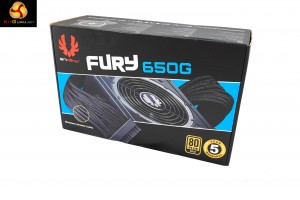
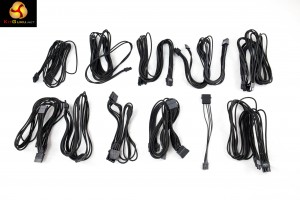
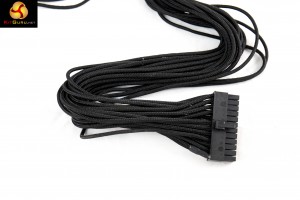
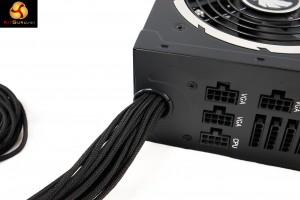
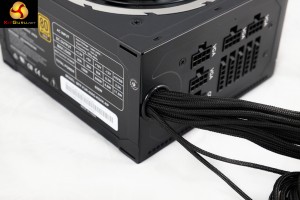
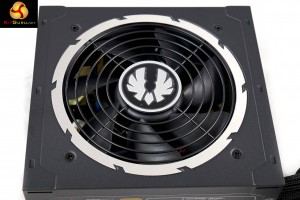
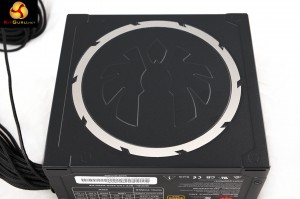
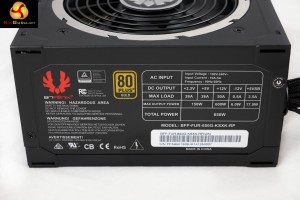
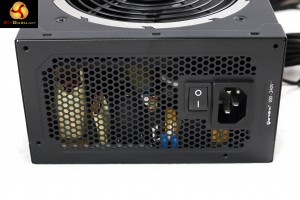
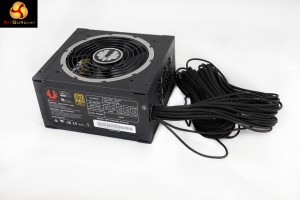
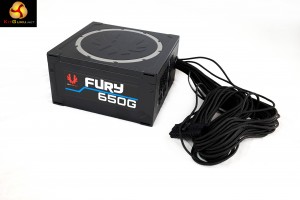
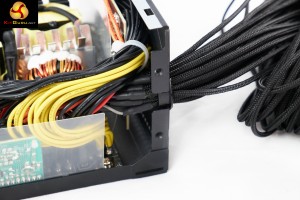
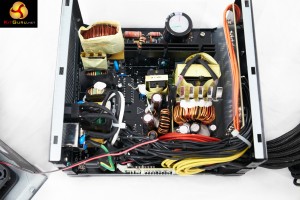
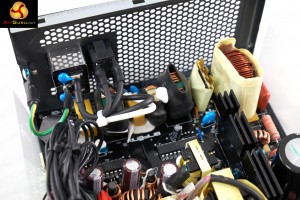
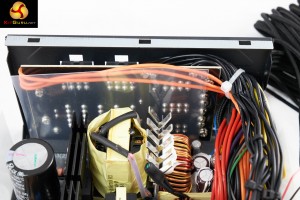
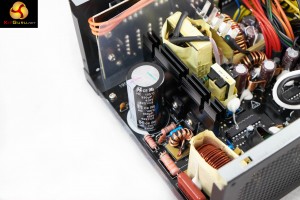
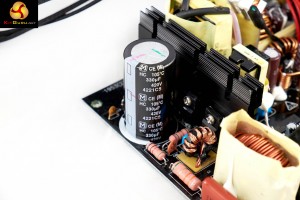
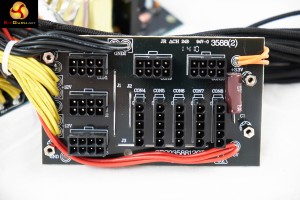
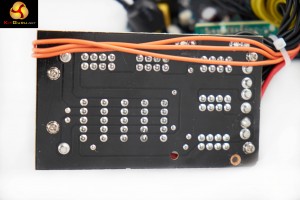
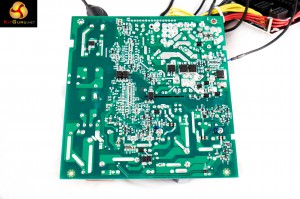
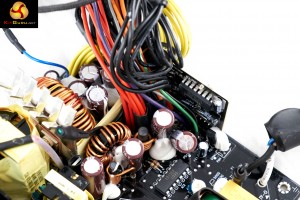
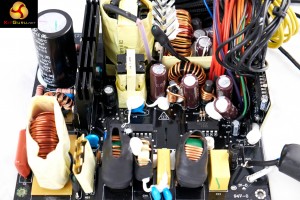
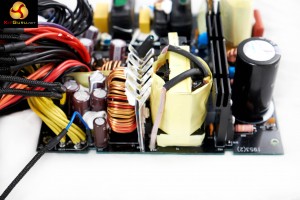
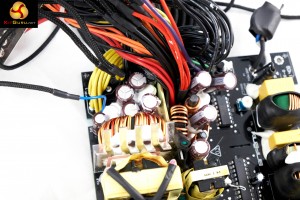
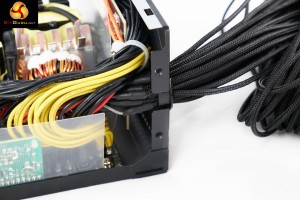
Additional technical assistance: Peter McFarland and Jeremy Price.
Correctly testing power supplies is a complex procedure and KitGuru have configured a test bench which can deliver up to a 2,000 watt DC load. Due to public requests we have changed our temperature settings recently – previously we rated with ambient temperatures at 25C, we have increased ambient temperatures by 10c (to 35c) in our environment to greater reflect warmer internal chassis conditions.
We use combinations of the following hardware:
• SunMoon SM-268
• CSI3710A Programmable DC load (+3.3V and +5V outputs)
• CSI3711A Programmable DC load (+12V1, +12V2, +12V3, and +12V4)
• Extech Power Analyzer
• Extech MultiMaster MM570 digital multimeter
• SkyTronic DSL 2 Digital Sound Level Meter (6-130dBa)
• Digital oscilloscope (20M S/s with 12 Bit ADC)
• Variable Autotransformer, 1.4 KVA
|
DC Output Load Regulation
|
||||||||||
|
Combined DC Load |
+3.3V
|
+5V
|
+12V
|
+5VSB
|
-12V | |||||
|
A
|
V
|
A
|
V
|
A
|
V
|
A
|
V
|
A | V | |
|
152W
|
2.08
|
3.37
|
2.04
|
5.03
|
10.14
|
12.24
|
0.50
|
5.01
|
0.20
|
-12.04
|
|
270W
|
3.05
|
3.34
|
3.07
|
5.03
|
19.16
|
12.22
|
0.50
|
5.00
|
0.30
|
-12.07
|
|
400W
|
4.05
|
3.30
|
5.05
|
5.02
|
29.18
|
12.18 |
1.00
|
5.00
|
0.30
|
-12.06
|
| 523W |
6.08
|
3.28
|
7.06
|
5.02
|
38.31
|
12.02
|
1.50
|
5.01 |
0.30
|
-12.05
|
|
650W
|
8.00
|
3.26
|
9.02
|
5.01
|
48.00
|
11.82
|
2.50
|
5.00
|
0.30
|
-12.06
|
Load regulation is decent, although we noticed quite a fluctuation on the +12V rail, dropping to 11.82 at full load.
| BitFenix Fury 650W |
Maximum Load |
| 689W |
The power supply would shut down at 689W, gracefully. The protection circuitry worked well.
Next we want to try Cross Loading. This basically means loads which are not balanced. If a PC for instance needs 500W on the +12V outputs but something like 30W via the combined 3.3V and +5V outputs then the voltage regulation can fluctuate badly.
| Cross Load Testing | +3.3V | +5V | +12V | -12V | +5VSB | |||||
| A | V | A | V | A | V | A | V | A | V | |
| 590W | 1.0 | 3.36 | 1.0 | 5.04 | 48.0 | 11.76 | 0.2 | -12.06 | 0.50 | 5.02 |
| 145W | 12.0 | 3.23 | 15.0 | 5.01 | 2.0 | 12.23 | 0.2 | -12.08 | 0.50 | 5.03 |
Cross load results are at best ‘ok' and fall within safe parameters. Again there is quite a big drop on the +12V rail when we hit the supply quickly with 48 Amps. Far from the best results we have seen in recent months.
We then used an oscilloscope to measure AC ripple and noise present on the DC outputs. We set the oscilloscope time base to check for AC ripple at both high and low ends of the spectrum. ATX12V V2.2 specification for DC output ripple and noise is defined in the ATX 12V power supply design guide.
|
ATX12V Ver 2.2 Noise/Ripple Tolerance
|
|
|
Output
|
Ripple (mV p-p)
|
|
+3.3V
|
50
|
|
+5V
|
50
|
|
+12V1
|
120
|
|
+12V2
|
120
|
|
-12V
|
120
|
|
+5VSB
|
50
|
Obviously when measuring AC noise and ripple on the DC outputs the cleaner (less recorded) means we have a better end result. We measured this AC signal amplitude to see how closely the unit complied with the ATX standard.
| AC Ripple (mV p-p) | ||||
| DC Load | +3.3V | +5V | +12V | 5VSB |
| 152W | 20 | 10 | 25 | 10 |
| 270W | 20 | 15 | 30 | 10 |
| 400W | 25 | 20 | 35 | 10 |
| 523W | 30 | 25 | 40 | 15 |
| 650W | 35 | 25 | 60 | 15 |
Ripple suppression rates as decent, although we would have liked to see a better result that 60mV from the +12V rail at full load. The +3.3V rail registered a peak of 35mV at full load, which again is a little higher than we would like to see. That said, none of the results are dangerous or outside industry specifications.
|
Efficiency (%)
|
|
|
152W
|
90.55
|
|
270W
|
92.18
|
|
400W
|
91.88
|
|
523W
|
90.89
|
|
650W
|
90.08
|
Efficiency is actually very good, peaking at around 92.2 percent at 50 percent load. At full load, this drops to close to 90 percent.
We take the issue of noise very seriously at KitGuru and this is why we have built a special home brew system as a reference point when we test noise levels of various components. Why do this? Well this means we can eliminate secondary noise pollution in the test room and concentrate on components we are testing. It also brings us slightly closer to industry standards, such as DIN 45635.
Today to test the Power Supply we have taken it into our acoustics room environment and have set our SkyTronic DSL 2 Digital Sound Level Meter (6-130dBa) one meter away from the unit. We have no other fans running so we can effectively measure just the noise from the unit itself.
As this can be a little confusing for people, here are various dBa ratings in with real world situations to help describe the various levels.
KitGuru noise guide
10dBA – Normal Breathing/Rustling Leaves
20-25dBA – Whisper
30dBA – High Quality Computer fan
40dBA – A Bubbling Brook, or a Refridgerator
50dBA – Normal Conversation
60dBA – Laughter
70dBA – Vacuum Cleaner or Hairdryer
80dBA – City Traffic or a Garbage Disposal
90dBA – Motorcycle or Lawnmower
100dBA – MP3 Player at maximum output
110dBA – Orchestra
120dBA – Front row rock concert/Jet Engine
130dBA – Threshold of Pain
140dBA – Military Jet takeoff/Gunshot (close range)
160dBA – Instant Perforation of eardrum
|
Noise (dBA)
|
|
|
152W
|
31.3
|
|
270W
|
32.5
|
|
400W
|
33.8
|
|
523W
|
35.8
|
| 650W | 38.8 |
The power supply is reasonably quiet until about 350 watts is demanded, then the fan starts to spin up. At 500 watts the fan spins faster to compensate for rising temperatures. At full load the fan spins quite hard and is noticeable and a little intrusive. That said, it is hardly practical to be running at full load for a long time.
We feel if the power supply was equipped with bigger heatsinks, then the fan wouldn't have had to work quite so hard under higher load situations.
|
Temperature (c)
|
||
|
Intake
|
Exhaust
|
|
|
152W
|
36
|
41
|
|
270W
|
39
|
46
|
|
400W
|
42
|
52
|
|
523W
|
43
|
55
|
|
650W
|
45
|
58
|
At full load, the exhaust temperature rose to 58c.
|
Maximum load
|
Efficiency
|
|
689W
|
89.8
|
Pushing the power supply above its rated limits generates an ultimate efficiency level of around 89.8%. This is not a viable ‘real world’ situation, but it is interesting nonetheless.
The BitFenix Fury 650W Gold Modular power supply is a decent first attempt by the company, although in some areas it does fall a little short when compared to the competition.
Bitfenix have partnered up with FSP and based the power supplies on the Aurum platform. This was never one of the most technically proficient platforms and is exhibiting some weak performance when compared against leading competitor products this year.
This power supply is targeting the mass enthusiast audience – those users with around £100 available who want a capable, good looking, reliable power supply for a new system build. I have no doubt that this power supply will serve a wide audience for many years … however it isn't quite as black and white as that.
FSP have equipped this power supply with very small heatsinks and even with 80 Plus Gold efficiency, the fan has to work relatively hard to keep temperatures in check. At higher load figures the fan spins very fast and the noise levels are a little intrusive. This is not a quiet power supply and it pales next to some of the latest, ultra quiet designs we have seen from the likes of Seasonic.
On a more positive note, we love the new individually sleeved ‘NanoSleeve' cables the company are incorporating with this range of power supplies. The enthusiast community are sure to love the cool appearance, especially when partnered up with a new windowed chassis.
Sadly, the competition in 2014 is intense. The Bitfenix Fury 650G doesn't deliver wonderful load regulation and it struggled a little with our intensive cross load test. Ripple suppression isn't remarkable either, with both +3.3V and +12V rails peaking a little higher than we would have liked -although within industry rated tolerances. Under load the fan spins fast and the noise levels are borderline bearable for us.
Right now the Bitfenix Fury 650W power supply is available from Overclockers UK for £109.99 inc vat. It is a pretty power supply and we love the fantastic looking NanoSleeve cabling. Technically however you can get a better power supply for around the same money.
Overclockers UK also stock 550W and 750W models in the Fury range – you can visit their main product page, over here.
Discuss on our Facebook page, over HERE.
Pros:
- Efficiency is good.
- Japanese capacitors.
- 5 year warranty.
- NanoSleeve cabling looks great.
Cons:
- Noisy under load.
- Struggled with Crossload.
- Ripple suppression could be better.
- Not cheap.
Kitguru says: An attractive looking power supply. Technically the unit is a little lacking compared to the best on the market in the same price category however.

 KitGuru KitGuru.net – Tech News | Hardware News | Hardware Reviews | IOS | Mobile | Gaming | Graphics Cards
KitGuru KitGuru.net – Tech News | Hardware News | Hardware Reviews | IOS | Mobile | Gaming | Graphics Cards


